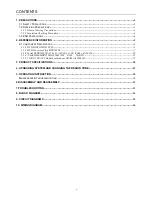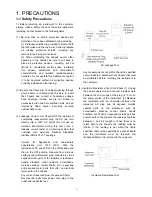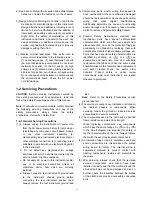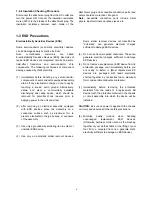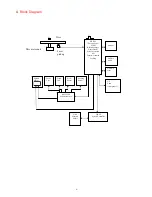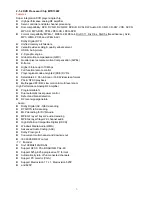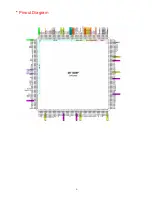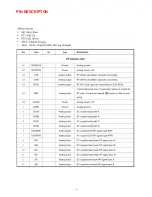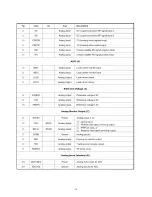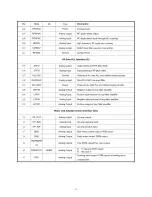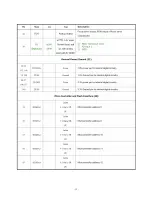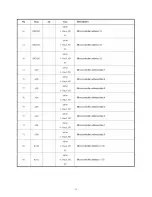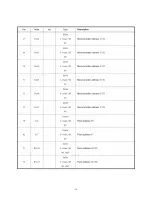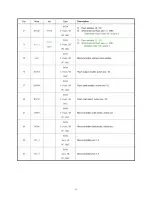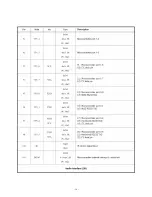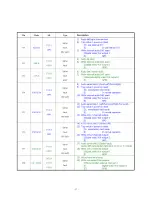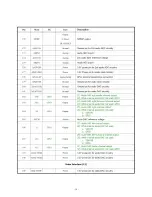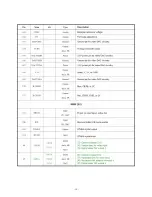
1-2-2 Insulation Checking Procedure
Disconnect the attachment plug from the AC outlet and
turn the power ON. Connect the insulation resistance
meter (500V) to the blades of the attachment plug. The
insulation resistance between each blade of the
attachment plug and accessible conductive parts (see
note) should be more than 1 Megohm.
Note:
Accessible conductive parts include metal
panels, input terminals, earphone jacks, etc.
1-3 ESD Precautions
Electrostatically Sensitive Devices (ESD)
Some semiconductor (solid static electricity) devices
can be damaged easily by static electricity.
Such compo9nents commonly are called
Electrostatically Sensitive Devices (ESD). Examples of
typical ESD devices are integrated circuits and some
field-effect transistors and semiconductor chip
components. The following techniques of component
damage caused by static electricity.
(1) immediately before handling any semiconductor
components or semiconductor-equipped assembly,
drain off any electrostatic charge on your body by
touching a known earth ground. Alternatively,
obtain and wear a commercially available
discharging wrist strap device, which should be
removed for potential shock reasons prior to
applying power to the unit under test.
(2) after removing an electrical assembly equipped
with ESD devices, place the assembly on a
conductive surface such as aluminum foil, to
prevent electrostatic charge buildup or exposure
of the assembly.
(3) Use only a grounded-tip soldering iron to solder or
unsolder ESD device.
(4) Use only an anti-static solder removal devices.
Some solder removal devices not classified as
“anti-static” can generate electrical charges
sufficient to damage ESD devices.
(5) Do not use freon-propelled chemicals. These can
generate electrical charges sufficient to damage
ESD devices.
(6) Do not remove a replacement ESD device from its
protective package until immediately before you
are ready to install it. (Most replacement ES
devices are packaged with leads electrically
shorted together by conductive foam, aluminum
foil or comparable conductive materials).
(7) Immediately before removing the protective
materials from the leads of a replacement ES
device touch the protective material to the chassis
or circuit assembly into which the device will be
installed.
CAUTION:
Be sure no power is applied to the chassis
or circuit, and observe all other safety precautions.
(8)
Minimize bodily motions when handling
unpackaged replacement ESD devices.
(Otherwise harmless motion such as the brushing
together of your clothes fabric or the lifting of your
foot from a carpeted floor can generate static
electricity sufficient to damage an ESD device).
- 4 -
Summary of Contents for DVD1451U
Page 1: ...GB SERVICE MANUAL DVD1451U MPEG4 PLAYER SERVICE MANUAL ...
Page 9: ... Pinout Diagram 8 ...
Page 10: ...PIN DESCRIPTON 9 ...
Page 11: ... 10 ...
Page 12: ... 11 ...
Page 13: ... 12 ...
Page 14: ... 13 ...
Page 15: ... 14 ...
Page 16: ... 15 ...
Page 17: ... 16 ...
Page 18: ... 17 ...
Page 19: ... 18 ...
Page 20: ... 19 ...
Page 21: ... 20 ...
Page 22: ... 21 ...
Page 25: ... 24 ...
Page 27: ...Pin Configuration 26 ...
Page 33: ... 32 6 Disassembly and Reassembly ...
Page 35: ... 34 8 Block Diagram ...
Page 39: ......


